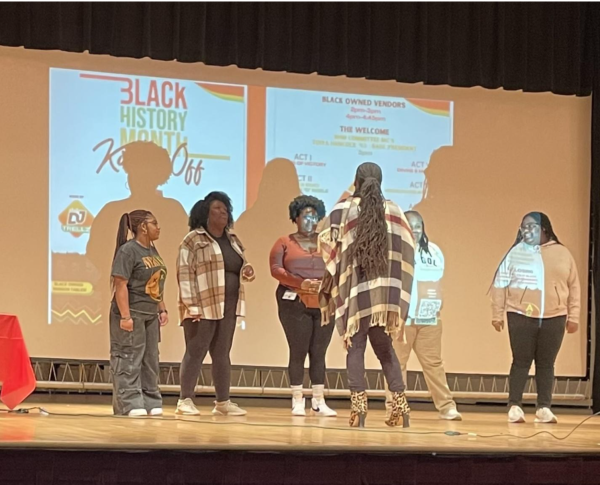IEC event examines issues of reproductive justice
On March 3, Guilford’s Intercultural Engagement Center (IEC) hosted a presentation on reproductive justice to kick off Women’s History Month. Krishauna Hines-Gaither, the director of Guilford’s IEC, discussed medical racism against Black women in the United States. Sonalini Sapra, the assistant director for UNCG’s Institute for Community and Economic Engagement, focused on caste and religious-based barriers to maternal health care for Indian women and the recently banned practice of commercial surrogacy in the country.
Hines-Gaither started the presentation by outlining the reproductive justice framework that she and co-presenter Sonalini Sapra used in their research. She said that this model defines reproductive justice as intersectional and international, emphasizing that reproductive justice must center on marginalized communities and address government and corporate responsibility. She referenced organization Sister Song, which focuses on birth justice, as a positive example of this framework in action.
Hines-Gaither cited Maya Hart, the North Carolina coordinator for Sister Song, to explain the organization’s work.
“Pregnant, birthing and postpartum Black people and people of color…are already struggling with a health care system rife with bias and negligence,” Hart stated.
Hines-Gaither discussed her experiences with seven years of infertility struggles before getting pregnant with her son, Giovanni. While pregnant, she learned last-minute that she had pre-eclampsia, a potentially fatal pregnancy complication characterized by high blood pressure. No one had informed her of this condition.
“We thought we had a month to go before we delivered,” she recalled. “(The doctor) said ‘this is life or death, go home, back your bags, and go straight to the hospital.’ To say that we were in shock is an understatement.”
She related this personal experience to broader national statistics. According to Hines-Gaither, Black women have the highest maternal death rate in the United States at 37 deaths per every 100,000 live births. Examining this high rate as a product of the extensive history of racial discrimination and medical invalidation of Black women in the United States, she focused on the eugenics movement and forced sterilization.
The pseudo-scientific eugenics movement in the United States targeted people for sterilization deemed “unfit” to have children in order to stop the generational transmission of perceived negative or undesirable traits. She said that this practice relied heavily on racial stereotyping and narrow conceptions of intelligence, elaborating that sterilization programs disproportionately targeted racial minorities, low-income populations, those with physical or mental disabilities and people with criminal backgrounds.
According to Hines-Gaither, the General Assembly authorized the castration of enslaved people who attempted to escape. While the law was ruled unconstitutional in 1929, a similar law introduced in 1933 allowed sterilizations to continue. 30 states officially participated in sterilization practices and North Carolina had the third-highest number of sterilizations. She stated that the state sterilized 7,600 people between 1929 and 1973, the date of the last recorded sterilization. The sterilization law was only officially repealed in 2003.
“This is why I tell my students that racism is sanctioned by the law,” she said.
After a brief intermission, Sonalini Sapra began her portion of the presentation. She first explained the personal impact that reproductive justice issues in India have had on her life. Sapra discussed how she grew up middle-class in India, but that her family comes from the Dalit or “untouchable” caste, a caste targeted in forced sterilization. Relating to her four-year struggle with infertility, Sapra explained how she traveled back to India during this time in her life and learned about reproductive tourism, a large international market for in vitro fertilization and fertility treatments, as well as commercial surrogacy.
Sapra then explained that despite high maternal mortality rates, India has been a hotspot that attracts foreigners for fertility treatments and surrogacies. She stated that there are 250 IVF clinics in India, and that before the ban on commercial surrogacy, there were several agencies devoted to the practice which emotionally and physically manipulated or mistreated their surrogate mothers.
Activists are concerned with this decision, as bans in one country can simply lead the industry to shift to another, and because the infrastructure already exists, it could continue illegally in India and put women at a greater risk of harm. Sapra said that activists would prefer to see the practice legalized, but regulated with fair pay requirements, safe working conditions, and extended health insurance coverage.
Attendee Ara Serjoie sympathized with the stories of the women discussed.
“I can’t help but think about all of the pain that is associated with all of this,” he said. “How are these women and their families able to recover from these experiences?”
“In many cases, the abuse just continues,” Hines-Gaither responded.
Encouraging participants to seek out involvement at organizations like Black Women’s Health Imperative, Sister Song and the International Women’s Health Coalition, both Hines-Gaither and Sapra pray for the creation of a more equitable healthcare future.







